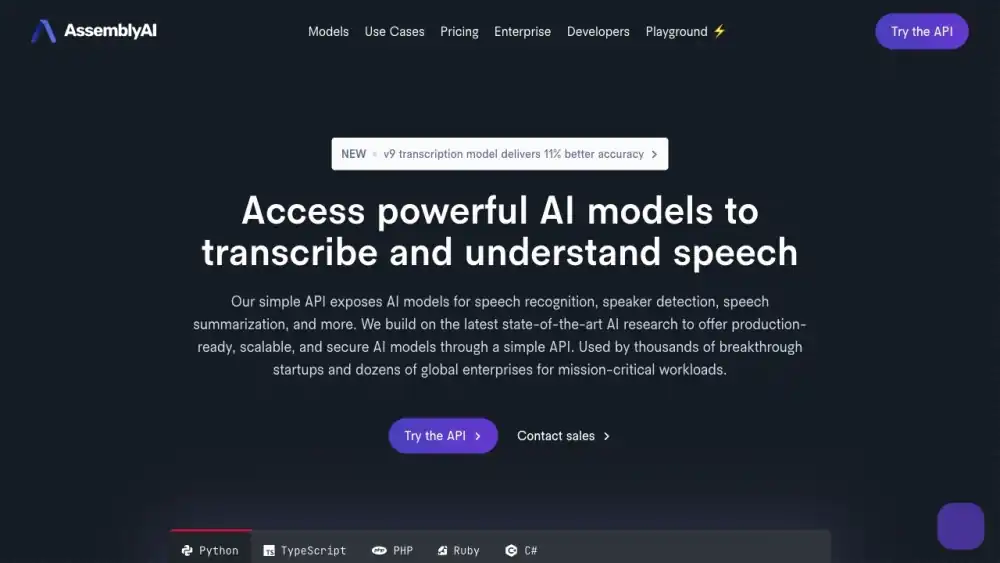AssemblyAI: Powering Audio Intelligence
AssemblyAI is a leading provider of speech recognition and audio intelligence solutions. Our advanced AI models enable developers to effortlessly transcribe audio and video content into text, extract valuable insights, and build innovative applications.
With a simple API, you can access powerful features including:
- Accurate speech-to-text transcription: Convert audio and video files into text with high accuracy.
- Speaker detection: Identify and separate different speakers in an audio file.
- Sentiment analysis: Understand the emotional tone of spoken content.
- Custom language models: Build custom models tailored to your specific use cases.
AssemblyAI’s commitment to cutting-edge technology and exceptional customer support makes it the ideal choice for businesses and developers looking to unlock the potential of audio data.
Would you like to know more about specific features or use cases for AssemblyAI?
AssemblyAI: Pros and Cons
Pros
- Accuracy: Offers high-quality transcriptions and accurate speech recognition.
- Versatility: Provides a wide range of features beyond transcription, including speaker detection, sentiment analysis, and custom models.
- Ease of Use: User-friendly API and documentation for seamless integration.
- Scalability: Handles large audio and video files efficiently.
- Cost-Effective: Competitive pricing for various usage levels.
Cons
- Potential Accuracy Issues: While generally accurate, transcription might have errors in specific accents, background noise, or complex speech patterns.
- Dependency: Reliance on a third-party service for audio processing.
- Data Privacy: Concerns about data security and privacy for sensitive audio content.
- Cost: Pricing can increase for heavy usage or advanced features.
- Feature Limitations: Specific features or customization options might be limited compared to building a custom solution.
Would you like to focus on a specific aspect of AssemblyAI, such as pricing, target audience, or specific features?
AssemblyAI Pricing: Pay-as-You-Go Model
AssemblyAI primarily operates on a pay-as-you-go pricing structure. This means you only pay for the audio processing you use.
Key Pricing Factors:
- Audio duration: The length of the audio or video file.
- Features used: Different features like speaker detection, sentiment analysis, or custom models might have varying costs.
- Usage volume: Discounts might be available for high-volume users.
AssemblyAI often offers a free tier to allow developers to experiment with the platform and its features. This is ideal for prototyping and small-scale projects.
For more detailed and up-to-date pricing information, it’s recommended to visit the AssemblyAI website directly.
Would you like to explore other aspects of AssemblyAI, such as target audience or specific features?
Alternatives to AssemblyAI
While AssemblyAI offers robust speech recognition capabilities, several other options are available:
Cloud-Based Speech-to-Text APIs
- Google Cloud Speech-to-Text: Leveraging Google’s AI expertise, offers high accuracy and various language support.
- Amazon Transcribe: Provides scalable speech-to-text conversion with integration into AWS ecosystem.
- Microsoft Azure Speech-to-Text: Offers real-time speech-to-text, speaker identification, and language identification.
- IBM Watson Speech-to-Text: Provides accurate transcriptions with customization options.
Open-Source Libraries
- Librosa: Python library for audio and music analysis, including feature extraction and conversion.
- SpeechRecognition: Python library for performing speech recognition tasks.
Considerations for Choosing an Alternative
- Accuracy: Evaluate the accuracy of transcription for different accents, noise levels, and speech styles.
- Features: Consider the specific features required, such as speaker identification, language detection, or custom models.
- Pricing: Compare pricing models and costs based on usage.
- Integration: Assess how the API integrates with your existing systems and workflows.
- Latency: Evaluate the speed of transcription for real-time applications.
Would you like to discuss your specific use case to determine the best alternative?
FAQs about AssemblyAI
General Questions
- What is AssemblyAI?
- AssemblyAI is a speech recognition API that converts audio and video into text.
- Who can use AssemblyAI?
- Developers, businesses, and individuals can utilize AssemblyAI for various applications.
- How accurate is AssemblyAI’s speech-to-text?
- AssemblyAI offers high accuracy, but results can vary based on audio quality, background noise, and speaker clarity.
Features and Functionality
- Does AssemblyAI support multiple languages?
- Yes, AssemblyAI supports various languages for transcription.
- Can I customize the transcription output format?
- AssemblyAI provides different output formats to suit various needs.
- Does AssemblyAI offer real-time transcription?
- Yes, AssemblyAI supports real-time transcription for live audio streams.
Pricing and Support
- How is AssemblyAI priced?
- AssemblyAI typically uses a pay-as-you-go pricing model based on audio duration and features used.
- What kind of support is available?
- AssemblyAI offers documentation, API reference, and community forums for support.
Would you like to focus on a specific AssemblyAI feature or explore other aspects like integration, compatibility, or performance?
Conclusion: AssemblyAI – Empowering Audio Intelligence
AssemblyAI stands as a pivotal player in the realm of audio intelligence, offering robust speech-to-text capabilities and beyond. Its accuracy, versatility, and ease of use make it a valuable asset for developers and businesses seeking to extract meaningful insights from audio data.
While the technology has made significant strides, it’s essential to recognize that speech recognition is still an evolving field. Factors like accent, background noise, and complex speech patterns can influence accuracy. Nonetheless, AssemblyAI’s commitment to continuous improvement positions it as a strong contender in the industry.
By leveraging AssemblyAI’s API, developers can unlock a world of possibilities, from transcription services and audio search to sentiment analysis and beyond. As the demand for audio-based applications grows, platforms like AssemblyAI will play an increasingly crucial role in shaping the future of human-computer interaction.
Would you like to explore specific use cases for AssemblyAI or discuss challenges in audio processing?
![]()






